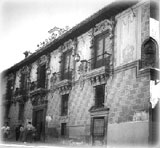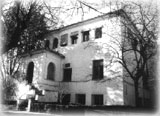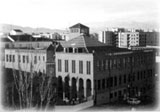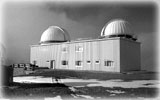Instituto de Astrofísica de Andalucía
The IAA has as its general scientific objective to help increase the bulk of knowledge about our universe, from the closest at hand, our solar system, to an overall scale of the entire universe, improving descriptions and analysing the physical processes that take place there. The nature of this aim demands a multi-disciplinary approach, requiring a combination of theory, observation and technology in different areas of physics and engineering. Although the IAA is a centre for pursuing basic science, we are aware of the role that astrophysics plays as a user and producer of new technologies.
To achieve our overarching objective, different scientific programmes are being undertaken with specific aims and timetables, encompassing four large areas of astrophysics: the solar system; star formation, structure and evolution; galaxy structure and evolution; and cosmology. Basic science has been and continues to be the motor for training scientific and technical staff, as well as for stimulating the development of other disciplines. The history of the IAA clearly depicts the observational function of the centre.
The telescopes installed in the Observatorio de Sierra Nevada (OSN), reflect a scientific policy with the clear objective of ensuring continued access to observational means to undertake far-reaching scientific projects. This fact adds singularity to the centre and at the same time offers the challenge and incentive for research at the IAA. The design and construction of instruments for the OSN, as well as others to be carried in special space vehicles, not only serve as support for basic research by the different teams of the IAA, but also represent activity of prime importance for the appropriate combination of research and development.
Brief history of the IAA
The decade of the 70s can be identified, without a doubt, as the time when modern astronomy began to surge in Spain. The new telescopes that were manufactured at that time in Europe had to be installed in prime places for astronomical observation and needed to be operated under optimal conditions, placing Spain in a privileged position. The United Kingdom, Germany, Sweden, and Holland, as well as other European countries, began to show interest in the astronomical conditions of certain regions, and, shortly afterwards, opened negotiations with the Spanish government to establish collaboration agreements in the sphere of astronomy.
Certain areas of the Canary Islands and the south-eastern Iberian Peninsula, which clearly stood out among a broad group of other potentially attractive places, became the sites of large observational complexes installed by Europeans in the Northern Hemisphere. La Palma, Tenerife, Almeria and Granada constitute the respective headquarters of the most important observatories of Europe. However, the situation of astronomical activities in Spain at that time was quite precarious, despite that in the mid-70s the country had launched an attempt to modernize the sector. Both in the Canaries and on the peninsula, notable effort was devoted to revitalizing old facilities (e.g., the Cartuja Observatory in Granada), or to redirecting other more recent ones towards more novel and competitive lines (e.g., Observatorio del Teide). In any case, these efforts were made under unfavourable conditions, and success was modest at best, without a hint of the profound change that was to come.
In this scenario, the Consejo Superior de Investigaciones Científicas (CSIC) sought to strengthen a traditionally very modest discipline within the "Alfonso el Sabio" Foundation, then in full force. The existence of small, active research groups at the University of La Laguna and University of Granada rproved to be a decisive factor prompting the CSIC to create the Instituto de Astrofísica de Canarias (IAC) and the Instituto de Astrofísica de Andalucía (IAA), with headquarters in La Laguna (1974) and in Granada (1975), respectively.
With regard to Granada, the CSIC had since the 1970s been supporting work by the Compañía de Jesús, owner of the Cartuja Observatory. At the time, this observatory, founded in 1902, had a mountain station situated on the Sierra Nevada mountain, at Mohón del Trigo peak (2,605 m in altitude), equipped with a small Cassegrain telescope with a 32-cm aperture, used jointly with the Royal Greenwich Observatory (RGO) of the UK for stellar-photometry studies. The station also had an automatic photometer, property of the Max Planck Institut für Aeronomie de Lindau (Germany), used to measure emissions of atmospheric atomic oxygen to study nightglow phenomena.
In 1972, an agreement was established between the Compañía de Jesús and the University of Granada, by which the Cartuja Observatory depended on the university, an agreement that remains in effect today.
Up to 1975, three doctoral and four master's theses had been carried out in the Cartuja Observatory. During this period, plans were made for the creation of the German-Spanish Astronomical Center at Calar Alto (Almería), at the same time as the foundations were laid for the construction of the Pico Veleta Observatory, the observation station of the French Institut de RadioAstronomie Millimetrique (IRAM), in a zone near the station of the Cartuja Observatory.
The proposal to create the IAA, put forward by the CSIC in July 1975, took this situation into account, and, using it for support, assumed, as one of the key factors for the new institute to take on a scientific profile, the need to have independent means of observation which, though modest, could enable the pursuit of intensive programmes along its own research lines. This permitted a notable independence of criteria, as well as an optimization of the use of large telescopes accessible in other observatories once its own observation instruments had been used to the limit of their possibilities.
Naturally, this did not constitute the only direction taken, but it was preferential. It was meant only to underline the need to provide independent viewpoints in this field of scientific activity, this being more feasible with instruments, infrastructure, and the ability to act alone, regardless of the necessary and important collaboration with other centres.
Whenever explicit reference is made to the early days of the IAA, emphasis falls on the difficulty of its beginning and first few steps. As opposed to the situation at La Laguna, the University of Granada did not participate directly in the project of the IAA; thus, without its own infrastructure, with scant economic resources, with a minimal staff, and without a physical place to be lodged, it can be said that the institute started from zero.

After multiple difficulties, in February 1976, the IAA set up provisional headquarters in the Madraza Palace in Granada, where Yusuf I in the 14th Century created the first madraza, the Islamic interpretation of a European university, a building that has been remodelled according to the different uses it provided over the centuries.
At these headquarters, the IAA continued to grow gradually in personnel and grant holders, resolving the difficulties that steadily arose and performing work which was both excellent and innovative.
The availability of the its own observation instruments was resolved minimally by means of an accord established between the University of Granada and the CSIC, by which all the instruments available in the Cartuja Observatory would be placed at the disposal of the IAA without restriction, at the same time as a collaboration channel was opened between the staff of the IAA and that of the university. Thanks to these measures, the IAA acquired its own observation means, which, though modest, enabled the institute to achieve its goal of becoming a modern research institute.
The enormous effort to create an instrumentation group is also noteworthy at this stage, with the aim of working on space projects designed to make in situ measurements of atmospheric emissions of probe rockets. The results outstripped the best expectations, thereby launching tasks that today have been fully accredited in the institute.

In 1978, the IAA was moved, also provisionally, to one of the buildings that the CSIC owned in Granada, situated within the complex known as the Estación Experimental del Zaidín (EEZ).
The need to have its own observational facilities was expressed in negotiations not only with the Royal Greenwich Observatory (RGO) but also with the Observatoire de Nice, both finally giving rise to agreements between the CSIC and the English Science & Engineering Research Council (SERC), on the one hand, and, on the other, the CSIC itself with the French Centre Nationale pour la Recherche Scientifique. In this way, the CSIC made a commitment to construct the Sierra Nevada Observatory (OSN) on the slope Veleta Peak, and the foreign institutions in compensation donated two telescopes, of 60 and 75 cm, respectively, to be installed in this observatory and to be used jointly. This also implied the need for the IAA to procure new instruments, some of which would be developed at the institute itself.

At the same time, earlier efforts were making it possible for the activities of the institute to be perfor-med at definitive faci-lities in the city of Granada, specifically adapted to the pecu-liarities of an astrophysics institute focused on the future. Thus the CSIC finally approved the construction of a building on land owned by the institution itself, near the road to the Sierra Nevada, intended for easy access from the city of Granada to the observatory. This building was inaugurated in 1986 and, since then, has expanded its facilities according to all the needs that have continued to arise.
The situation of the OSN, although better than the first in the Cartuja Observatory, was far from satisfactory and therefore in this field a lasting solution, though not definitive was sought. The first thoughts were to make basic instruments available that would be property of the institute for research tasks without being subject to technical drawbacks of the steadily poorer features of the old telescopes available.

The idea took definitive form when, after a number of initial contacts, a programme was specified in which the CSIC and the Chinese Academy of Sciences agreed to collaborate in the construction of two telescopes, of 0.9 and 1.5 m, respectively, and the corresponding control equipment, under economic conditions that were highly favourable for the CSIC. The accords were signed in 1987 and the installation of two telescopes at the OSN began in the summer of 1991.
The installation of the two new telescopes appeared to mark the first phase of equipping the institute with basic instruments, placing the IAA in the position to take on scientific and technical challenges of its own.
